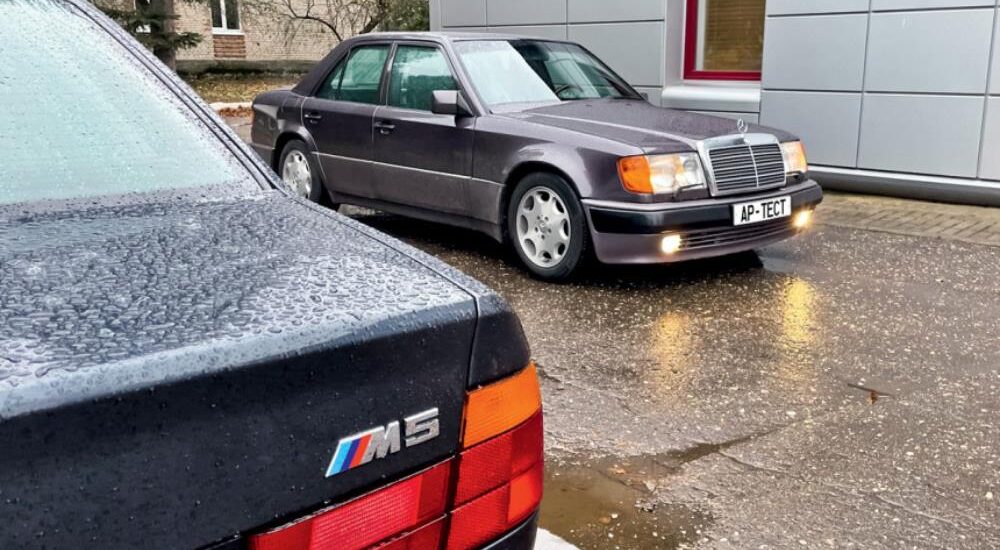Коли Mercedes анонсувала W124, BMW виступила проти E34. Відповідь Мюнхена була гучною та чіткою, проголошенням M5, а Штутгарт швидко відреагував із 500 E. Цікаво, що, незважаючи на різкі відмінності між цими суперседанами, у них була особлива відправна точка — обидва починали свою подорож у кузові вантажівки.

Проект W124 розпочався в 1977 році з початковим дизайном, створеним Пітером Пфайфером і Йозефом Галлітцендорфером, і був завершений керівником центру дизайну Бруно Сакко.
Безсумнівно, тон суперництва задав BMW у 1980-х роках, керований прагненням випередити Mercedes. Конкуренція була настільки жорстокою, що Мюнхену довелося подвоїти свої зусилля, щоб просто продовжити переслідування. Їм потрібен був прорив, щоб отримати перевагу, що сталося з випуском E32 «Seven» у 1986 році, а роком пізніше — BMW 750i з двигуном V12. Тоді завдання полягало в тому, щоб повторити цей успіх із «П’ятіркою».
Випущені в 1988 році седани E34 були розроблені з особливою метою — перевершити грізний W124. Через чотири роки після свого дебюту Mercedes все ще залишався дивом автомобільної техніки. Під час нашого ретро-тесту я заглибився в BMW Praxis, дилерський каталог, який використовується для навчання торгових партнерів новій «п’ятірці». Цей 240-сторінковий посібник є скарбницею деталей про E34, наповнених ідеями, які рідко можна знайти в інших місцях.
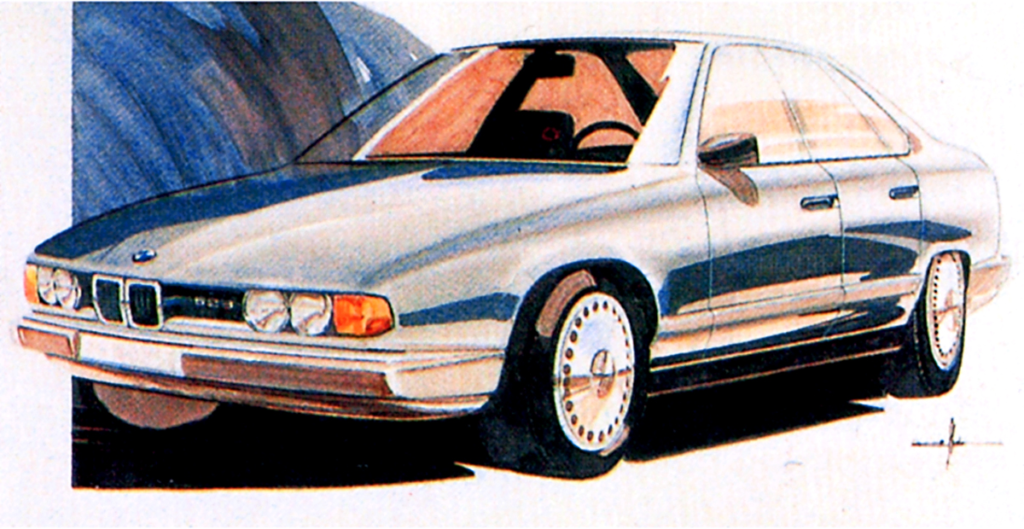
Італійські гени E34 були намальовані в 1982 році Ерколе Спада. Роботу над «П’ятіркою» продовжив Джей Мейс, а завершив під керівництвом Клаус Люте.
Від маркетингових стратегій до технічних інновацій – суперництво було напруженим. Компанія BMW проаналізувала частки ринку в різних професіях, зазначивши перевагу «Пропелер» серед керівників середньої ланки та «Зірка» серед топ-менеджерів і фрілансерів. BMW також рекламувала покращення аеродинаміки, заявивши про покращення на 18% у порівнянні з попередником і досягнувши коефіцієнта лобового опору 0,30, зберігаючи при цьому свій культовий дизайн решітки радіатора. Вони тонко натякнули, що їхні результати могли бути ще кращими, якби не їхня стандартна політика щодо шин — удар по Mercedes, чиї найкращі аеродинамічні показники були досягнуті з вужчими шинами.

Баланс між функціональністю (вертикальна вісь) та естетикою (горизонтальна вісь) у розумінні BMW. Виявляється, Lancia найменш практична, тоді як Audi вважається найменш красивою.
Такі інновації, як унікальна система склоочисників Mercedes, яка очищала 86% вітрового скла, зустрілися з розширеними склоочисниками BMW, які відповідали площі очищення, але додали механізм для кращої роботи леза на низьких швидкостях. Подібним чином, у той час як Mercedes міг похвалитися автоматичним підігрівом дзеркал і форсунок, BMW представив механізм замка з підігрівом, який активується, тримаючи дверну ручку — особливість продуманої інженерії.

Очевидно, наскільки по-різному компанії працювали з інтерфейсом. Для Mercedes оптика та решітка радіатора діють як аеродинамічний інструмент, який допомагає зменшити підйомну силу. Для BMW фари – це, перш за все, обличчя марки. Тим не менш, каталог BMW Praxis наводить інтригуючі цифри: для подолання опору повітря на швидкості 180 км/год E34 потрібно 64 к.с., а на 200 км/год — 87 к.с. Це на 20% менше, ніж у його попередника E28 із подібним акулячим носом.
Кожна модель має функції, які перевершують інші. Знаменита п’ятиважільна задня підвіска Mercedes була зустрінута з удосконаленнями BMW у існуючих налаштуваннях E34, включаючи амортизатори з електронним керуванням і систему рульового управління Servotronic. BMW також відповів на Mercedes ASR своєю вдосконаленою системою ASC+MSR, яка враховувала не тільки тягу, але й блокування коліс під час уповільнення.
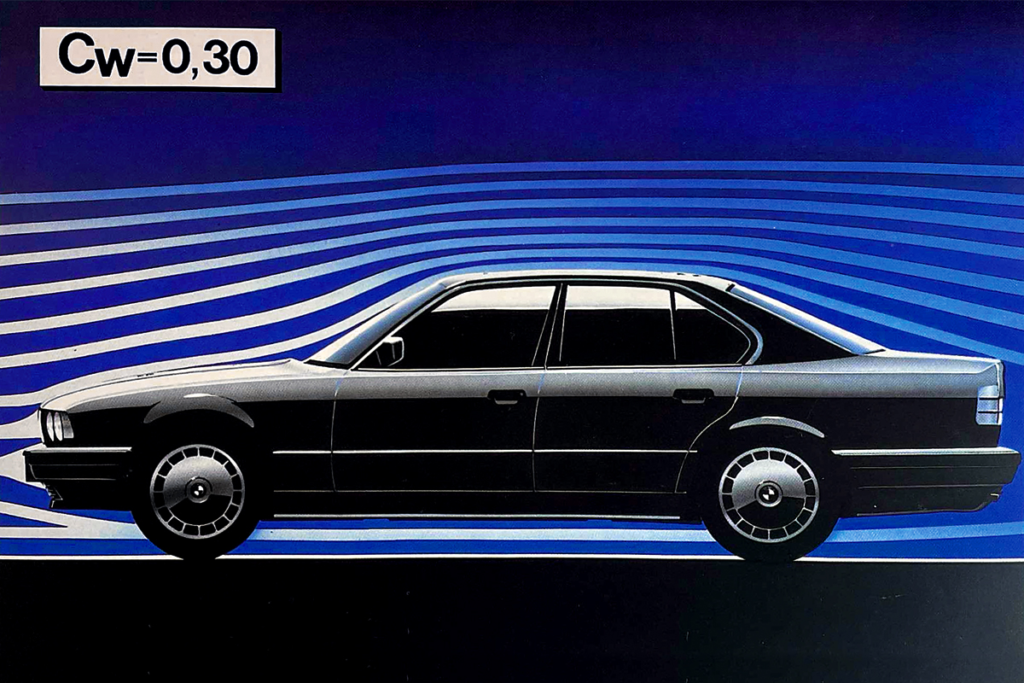
У каталозі навіть наведено обґрунтування характеристик керованості M5, припускаючи, що BMW навмисно налаштувала шасі на нейтральну або невелику недостатню поворотність, яка могла переходити в надмірну поворотність за допомогою введення газу, імовірно, щоб протистояти характеру Mercedes, що задовольняє хвіст.
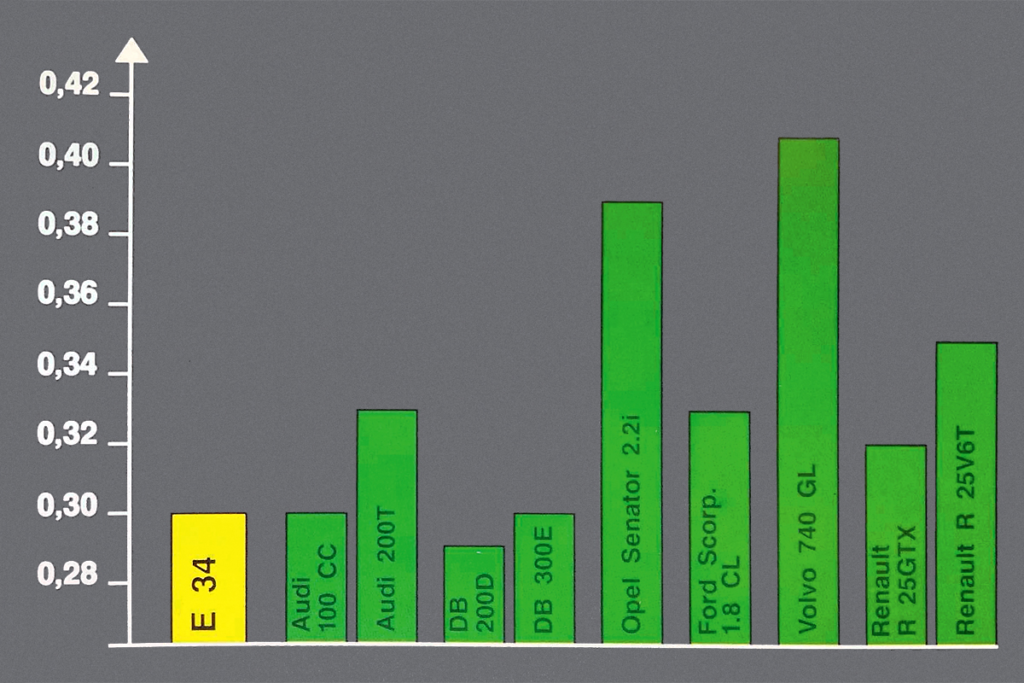
Аеродинаміка як класики, так і сучасників. Щоб наздогнати Mercedes, BMW витягла співробітників з Audi.
Ця безперервна боротьба за перевагу не тільки розсунула технологічні межі, але й підкреслила глибоке суперництво. Хоча E34 на мить випередив W124, він не зміг відтворити революційний вплив V12 E32. Незважаючи на спільну платформу з «сімкою», «п’ятірка» завжди здавалася на крок позаду свого штутгартського колеги, переслідуючи такі інновації, як повний привід і покращення безпеки, які впровадив Mercedes.
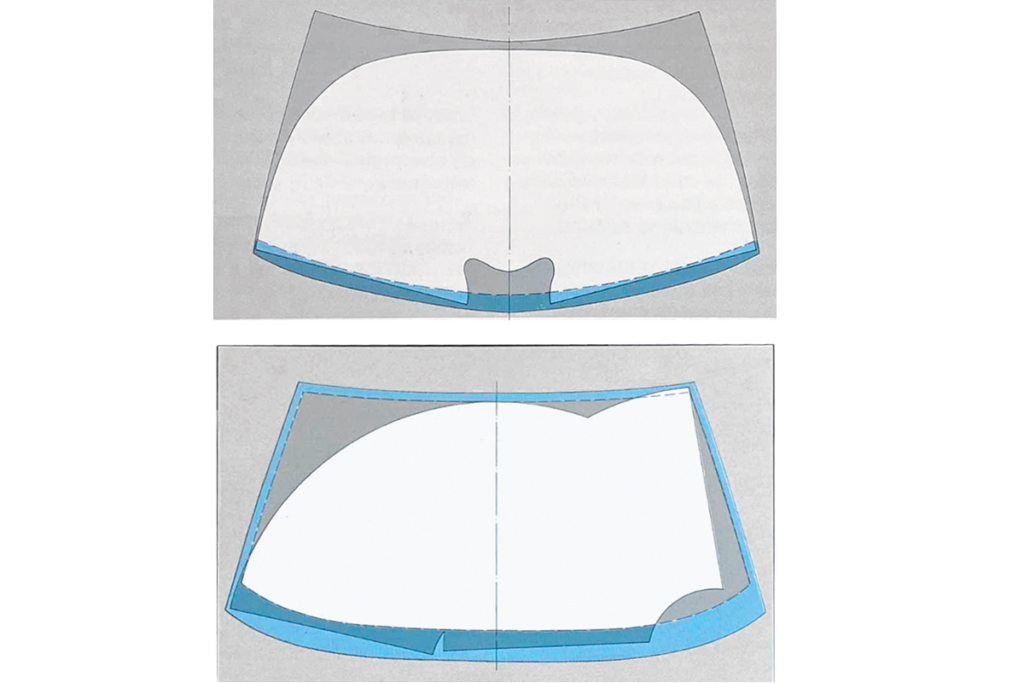
Склоочисник Mercedes досягає верхніх кутів і забезпечує рекордну для автомобільної промисловості площу очищення лобового скла. BMW наполягає, що лівий верхній кут важливіший для видимості на світлофорі.
BMW M5 залишається свідченням цієї жорсткої конкуренції, втілюючи невпинне прагнення до досконалості та інновацій у сфері автомобільної промисловості. Коли ці суперники підштовхували один одного до більших висот, вони залишили спадщину інженерної майстерності та продуктивності, яка продовжує надихати автомобільний світ.
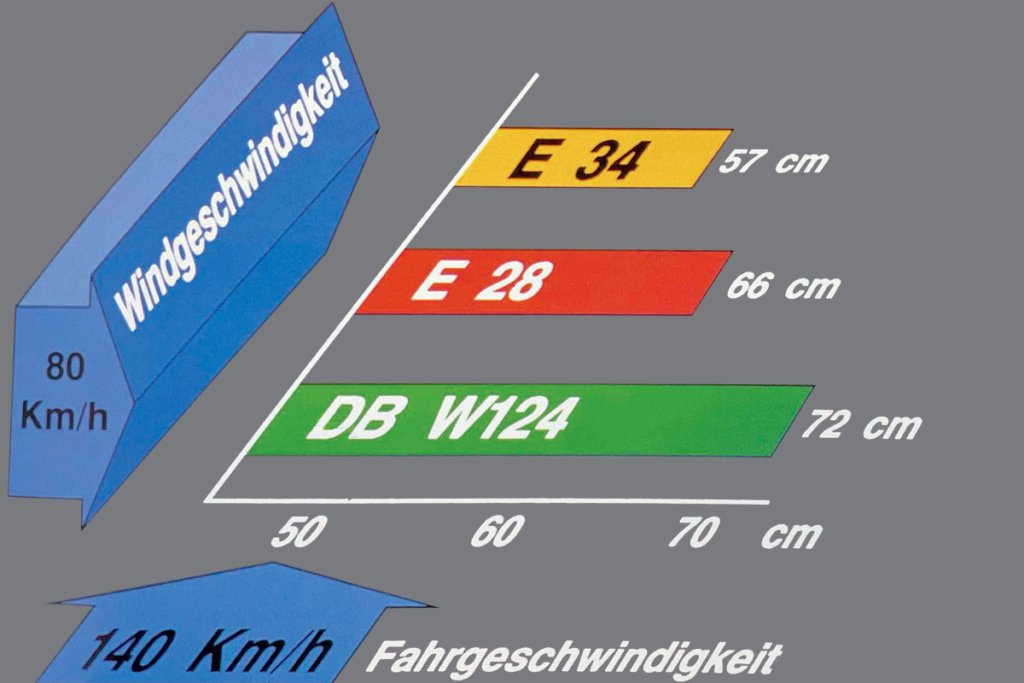
Ще одна причина підкреслити перевагу над Mercedes: при бічному вітрі E34 дрейфує менше, ніж W124.
Коли Mercedes представив W124, BMW швидко відреагував, випустивши E34, проголосивши свій власний шедевр, M5. Штутгартський лічильник, 500 E, ознаменував початок захоплюючого суперництва між двома абсолютно різними суперседанами, обидва з яких мають дивовижне походження: кожна модель починала своє життя на шасі вантажівки.
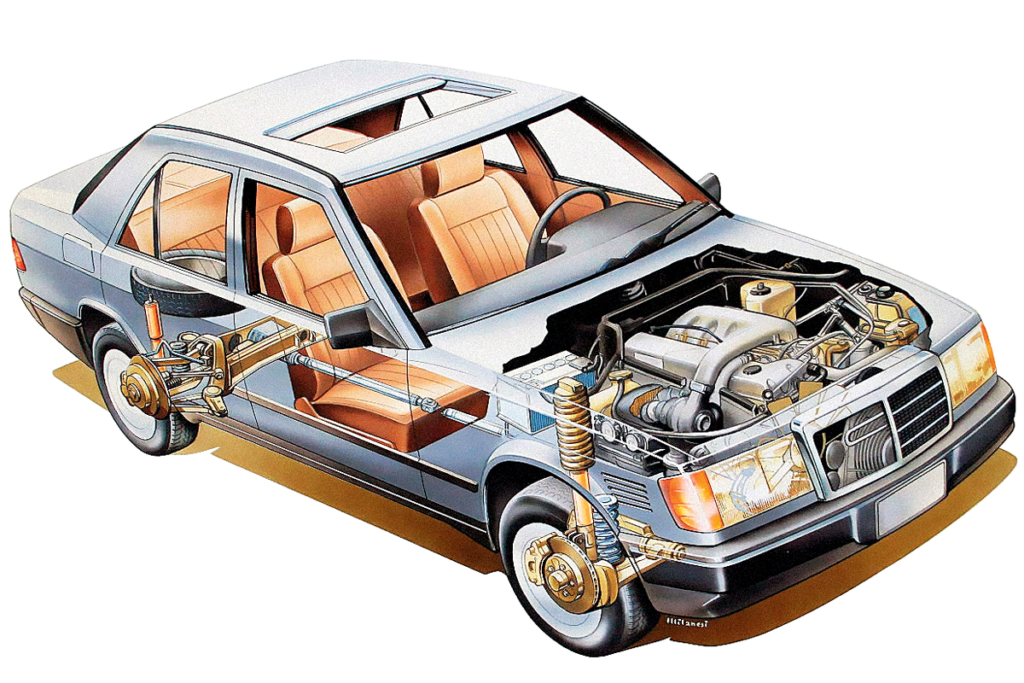
Головною технічною перлиною шасі W124 є задня багатоважільна підвіска, яка з’явилася трохи раніше на менших седанах W201 і згодом встановлювалася практично на всі легкові автомобілі Mercedes. Його скопіювали багато інших виробників. З модифікаціями ця базова п’ятиланкова схема використовується й сьогодні.
У 1980-ті роки BMW палко прагнула перевершити Mercedes. Штутгарт був грізним, змусивши Мюнхен подвоїти свої зусилля, щоб не відставати. Щоб перевершити Mercedes, BMW потрібно було щось надзвичайне. Вони вийшли на ринок у 1986 році з дебютом E32 «Сімка», а роком пізніше здивували автомобільний світ BMW 750i з двигуном V12. Завдання полягало в тому, щоб повторити цей успіх із «П’ятіркою».
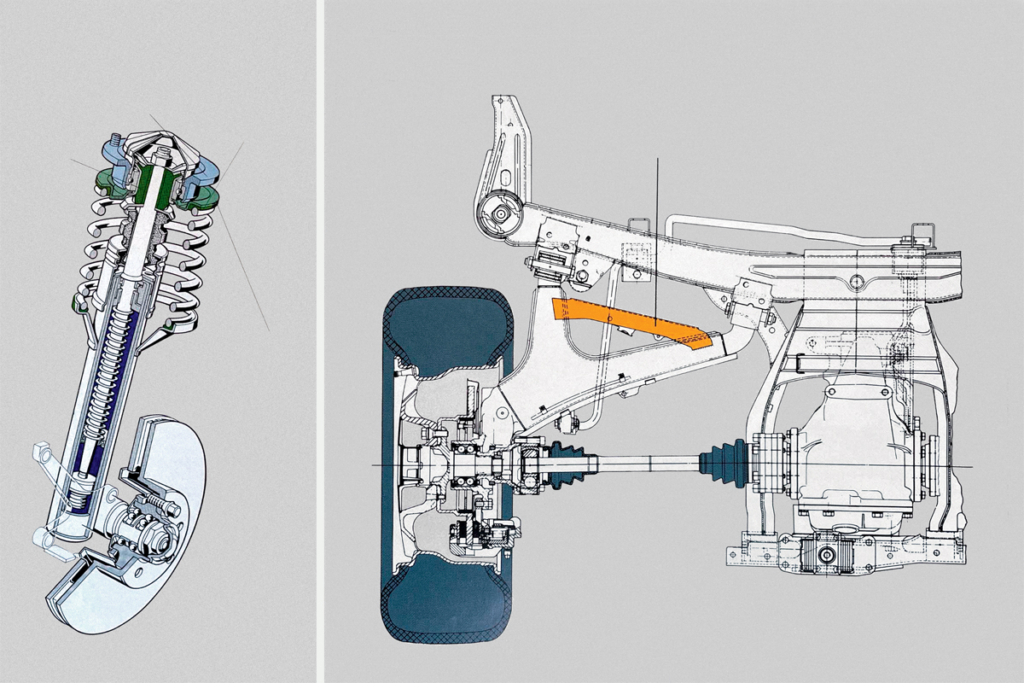
Для всіх версій E34 вище BMW 525i і 524td були передбачені стійки McPherson з окремими кріпленнями пружин і амортизаторів. Ззаду косі плечі були посилені підкосами. Це була остання «п’ятірка» з таким олдскульним заднім мостом. В якості опції, крім М5, пропонувалася більш жорстка підвіска Sport.
Випущені в 1988 році седани E34 були спрямовані лазером на одну ціль — видатний W124. Через чотири роки після свого дебюту Mercedes все ще був уособленням вершини автомобільної інженерії.
Під час нашого ретроспективного тестування я провів кілька днів з унікальним дилерським каталогом BMW Praxis, призначеним для навчання торгового персоналу новій «п’ятірці». Ця 240-сторінкова біблія E34 охоплює кожну деталь і дизайнерське рішення автомобіля. Він наповнений унікальними знаннями та має ціну 30 000 рублів, що свідчить про його цінність. Примітно, що W124 згадується майже на кожній сторінці, підкреслюючи очевидну одержимість.
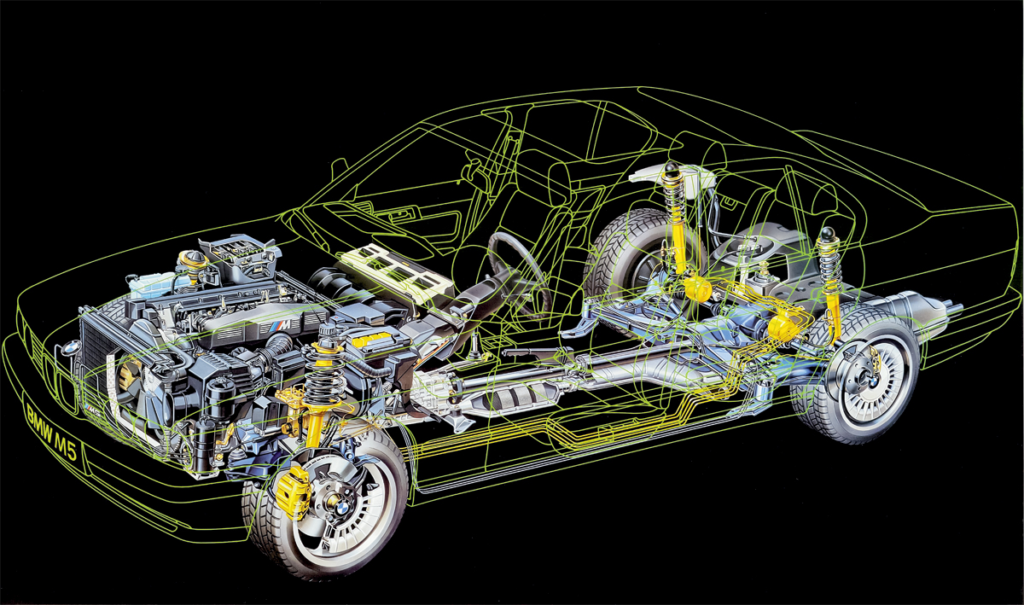
Подібна складна багатоважільна підвіска BMW з’явилася тільки в 1989 році на купе E31, а потім на «сімці» E38 і «п’ятірці» E39. Але M5 E34, ще до випуску Mercedes 500 E, стандартно оснащувався задніми амортизаторами з гідравлічним механізмом самовирівнювання для підтримки постійних кутів розвалу коліс і кліренсу.
Битва почалася з маркетингових стратегій, коли BMW детально порівняла частки ринку між різними професіями. Бренд «Пропелер» більше резонував серед менеджерів середньої ланки, тоді як «Зірка» знайшов прихильність серед топ-менеджерів і фрілансерів. BMW також похвалився інженерними досягненнями, стверджуючи про значне аеродинамічне вдосконалення в порівнянні зі своїм попередником і досягнення коефіцієнта лобового опору 0,30, зберігаючи при цьому знаковий негативний нахил ніздрів. Це тонко натякало на те, що ці результати могли бути навіть кращими, натякаючи на те, що такі конкуренти, як Mercedes, використовували вужчі шини для досягнення оптимальних показників.
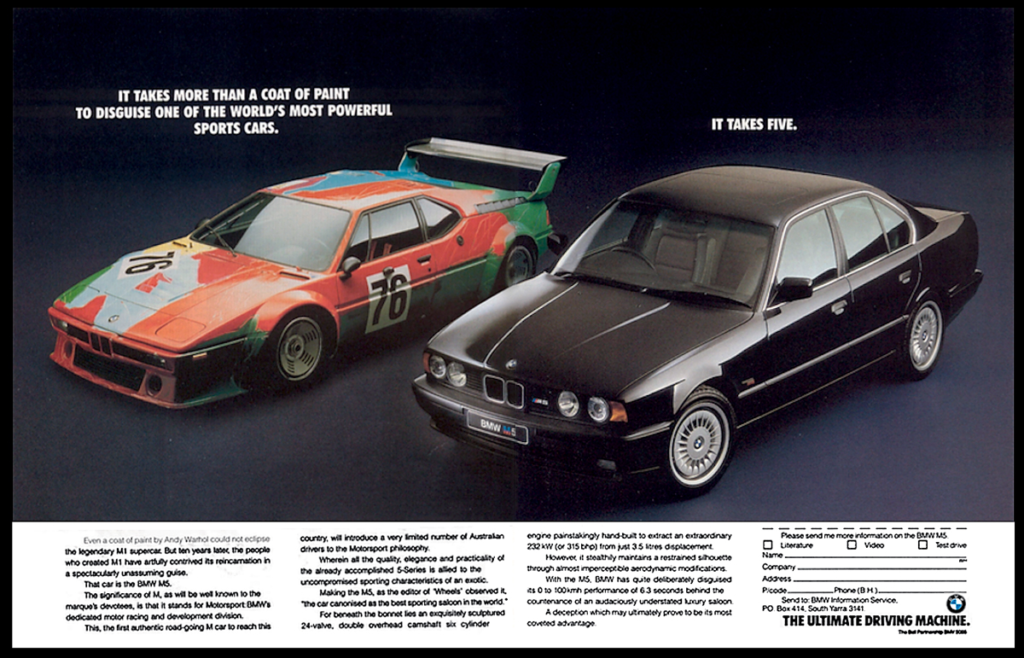
Родовід двигунів M5 традиційно ведеться від «шістки» M88 BMW M1, хоча справжнім прабатьком став BMW 3.0 CSL. Версія M88/3 без сухого картера була призначена для E28 M5 в Європі, а перший двигун з маркуванням S38B35 був його «каталітичною» версією для Америки. Двигуни S38 на E34 успадкували залізний блок і 24-клапанну головку DOHC.
BMW доповнила інноваційну систему склоочисників Mercedes, яка очищала 86% скла, розширивши зону дії склоочисників і додавши в основу механізм для покращення зчеплення щіток на низьких швидкостях. Вони також представили унікальну функцію, коли потягнути та утримувати дверну ручку активує нагрівач замка, розумне доповнення для холодного клімату.
Від складаних задніх підголівників, які керуються сервоприводами замість пружин, до більш складної системи контролю тяги, яка керувала як втратою тяги, так і раптовим уповільненням, BMW, здавалося, була налаштована не тільки конкурувати, але й лідирувати в інноваціях. Нові характеристики кожної моделі мали на меті перевершити інші, а BMW постійно вдосконалював свій дизайн, щоб відповідати прогресу Mercedes.
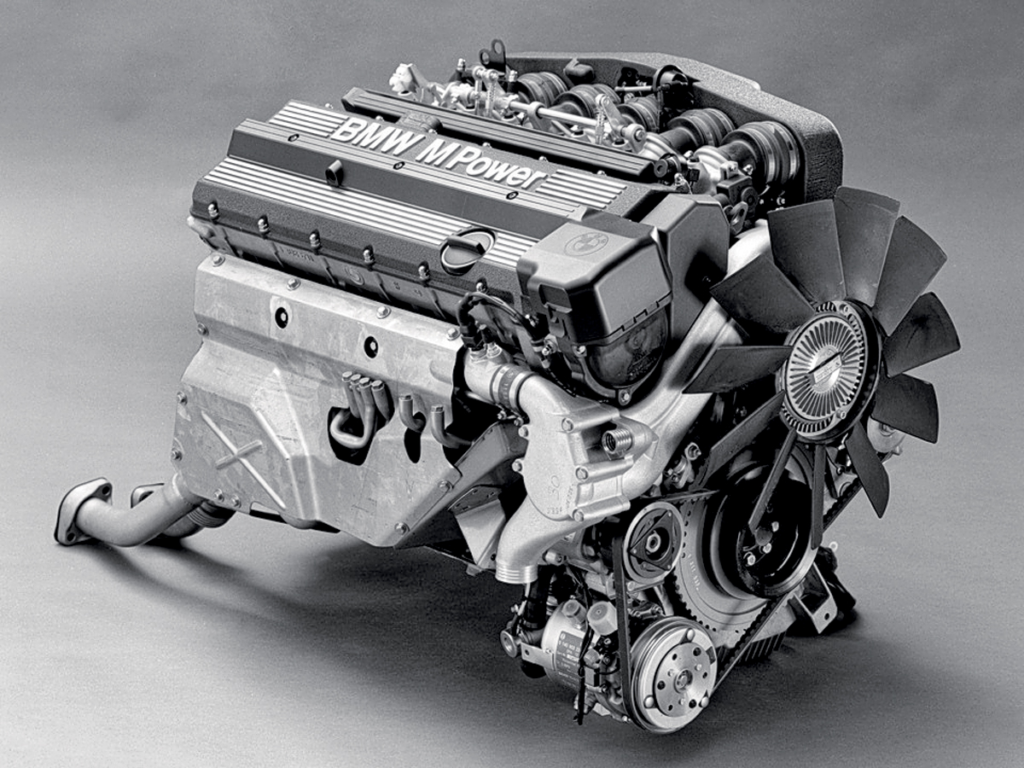
Двигун S38B36 (315 к.с.) попереднього рестайлінгу M5 фактично мав об’єм 3535 куб.см, але отримав позначення 3,6, щоб відрізняти його від двигуна-попередника з об’ємом 3453 куб.см на M5 E28.
Більше того, каталог BMW надав обґрунтування характеристик керованості M5, вказуючи на навмисне налаштування від нейтральної до легкої недостатньої поворотності, яка могла переходити до надмірної поворотності під час прискорення — можливо, кивок на «дрифтову» природу «124».
Це око за око суперництво не тільки розсунуло межі автомобільних технологій, але й підкреслило інтенсивний конкурентний дух між двома брендами. Незважаючи на те, що E34 ненадовго випередив W124, він не зміг відтворити новаторську потужність дванадцятициліндрового E32. Незважаючи на спільну платформу з «сімкою», «п’ятірка» завжди була в погоні, впроваджуючи такі інновації, як кузови універсал, повний привід і покращені функції безпеки, які повторюють ті, що вперше впровадив Mercedes. BMW M5 залишається пам’ятником цього жорстокого суперництва, демонструючи, як конкуренція сприяє інноваціям і досконалості в автомобільній промисловості.
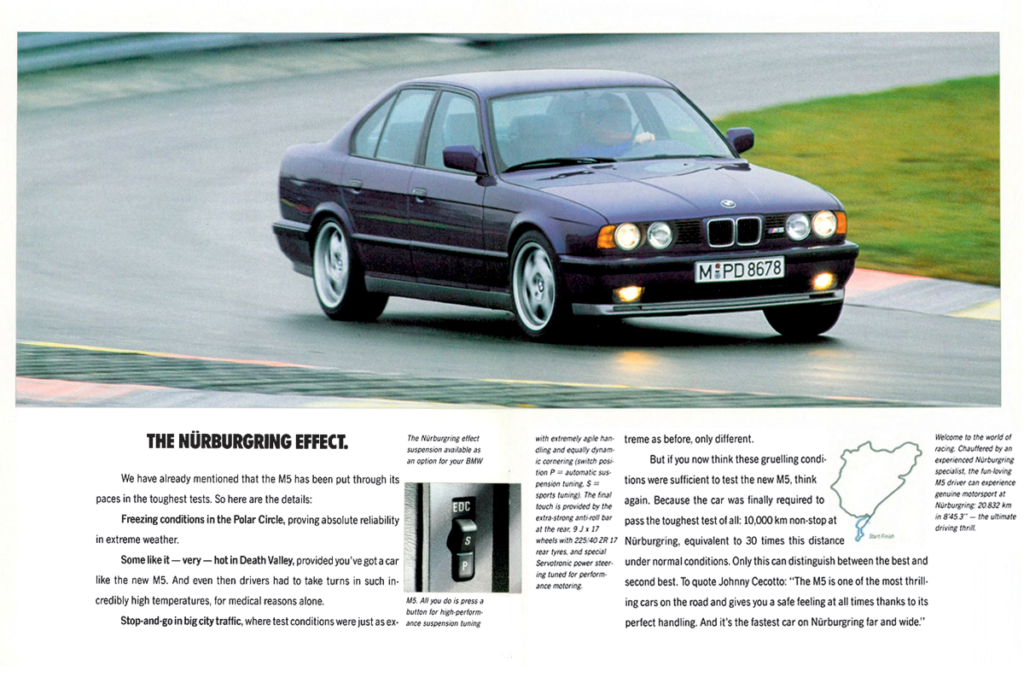
Ефект Нюрбургринга означає, що під час випробувань седан BMW M5 з адаптивними амортизаторами EDC пройшов без зупинок десять тисяч кілометрів на «Північній петлі» Нюрбургринга та зафіксував найкращий час 8’45,3″ (на трасі 20 832 км).
Три роки тому, щоб відзначити 30-річчя Mercedes 500 E, прес-служба Porsche опублікувала інтерв’ю з Міхаелем Хельшером, керівником проекту Typ 2758. Подальші виступи Хельшера в подкастах пролили світло на нюанси розробки цієї культової моделі. Він уточнив, що компонування седана, вибір двигуна та трансмісії родстера 500 SL, а також його дизайн та аеродинаміка були визначені виключно Mercedes. Перш за все перед Porsche було поставлено завдання інтегрувати ці компоненти в шасі W124, яке спочатку не було розроблено для розміщення двигунів V8.
Ця співпраця вимагала значних адаптацій, включаючи переміщення впускних каналів, зміну маршруту гальмівної та паливної магістралей, коригування центрального тунелю, розширення колії та проведення комплексної програми водіння. Цікаво, що Mercedes вирішила не включати налаштування Нюрбургринга в цей проект, підкреслюючи сценарій, коли специфікації клієнта були першочерговими для Porsche.
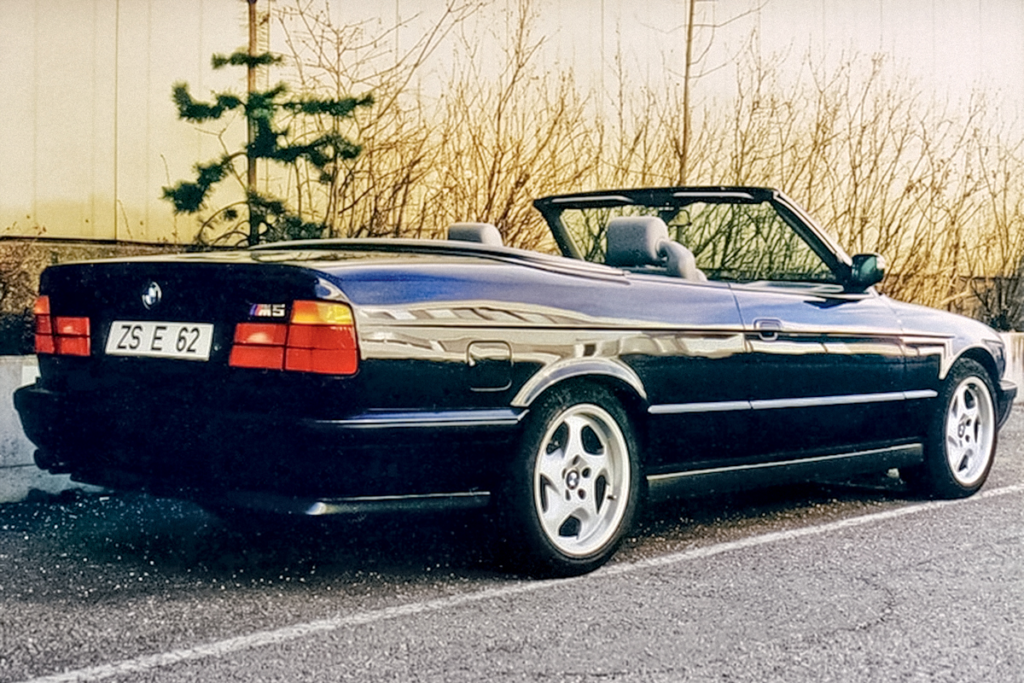
На Женевському автосалоні 1989 року повинен був бути показаний кабріолет M5 з кузовом E35, але за тиждень до прем’єри BMW побоювалася, що це зашкодить попиту на відкритий M3, і скасувала проект. Прототип був представлений лише в 2009 році.
Помітним нововведенням Цуффенхаузена стала розробка електронної системи керування двигуном. Дійсно, 500 E був піонером як для Mercedes, так і для Porsche, оскільки це був перший автомобіль, обладнаний системою CAN-bus.
Хельшер також розвінчав міф про те, що 500 E не може бути розміщений на конвеєрі в Зіндельфінгені через його надмірно широкі передні крила, які, за чутками, були розроблені Porsche. Він пояснив, що ці крила насправді були задумані дизайнерами Mercedes, які добре знали про обмеження конвеєра. Рішення не модернізувати обладнання заводу в Зіндельфінгені для ширших крил, а натомість передати певні етапи виробництва Porsche було економічно ефективною стратегією. Це викликає інтригуючу можливість: можливо, Mercedes планував, щоб цей спеціальний седан збирався в унікальному місці, далеко від стандартних виробничих ліній, подібно до підходу BMW.
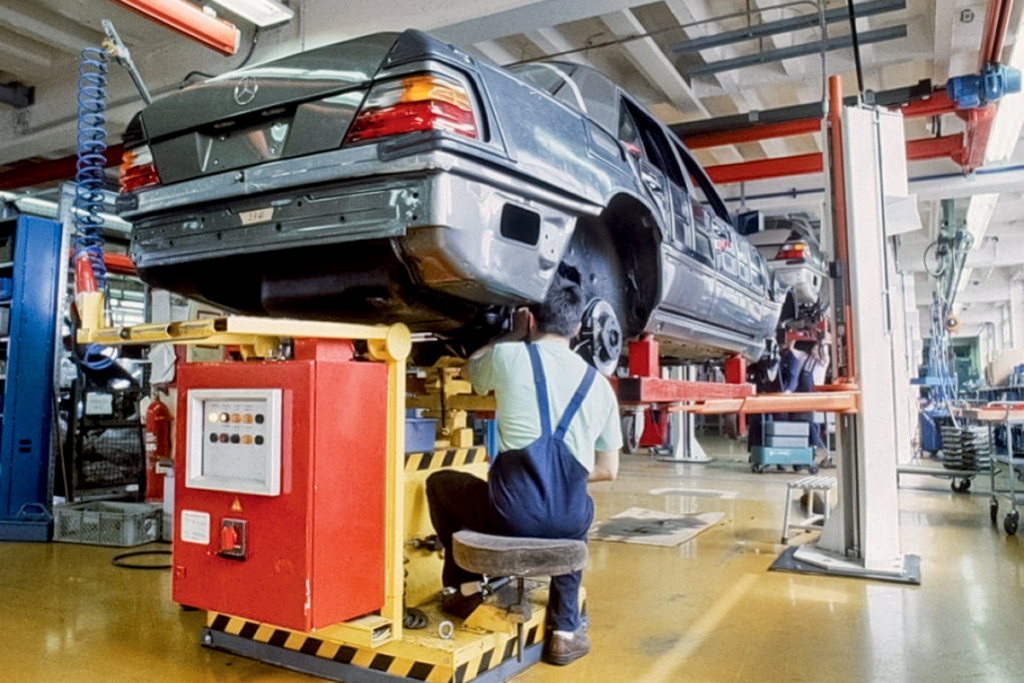
На заводі «Порше» автомобілі «Мерседес» збирали без конвеєра, на підйомниках і візках. VIN-код цих автомобілів повинен містити цифри 124.036.
Зрештою, Mercedes 500 E збирали в трьох місцях. Штамповані панелі кузова перевозили вантажівками із Зіндельфінгена до Цуффенхаузена, де компанія Porsche додавала деталі та збирала їх у рами в будівлі Reutter Bau, названій на честь історичної Reutter Karosseriewerk, кузовної майстерні, яка працювала з Фердинандом Порше з 1906 року та відіграла важливу роль у ранніх автомобілях Porsche. тіла. Після початкового складання рами повернули в Зіндельфінден для фарбування, а потім назад у Цуффенхаузен для остаточного складання на заводі Rössle Bau, де раніше випускався Porsche 959.
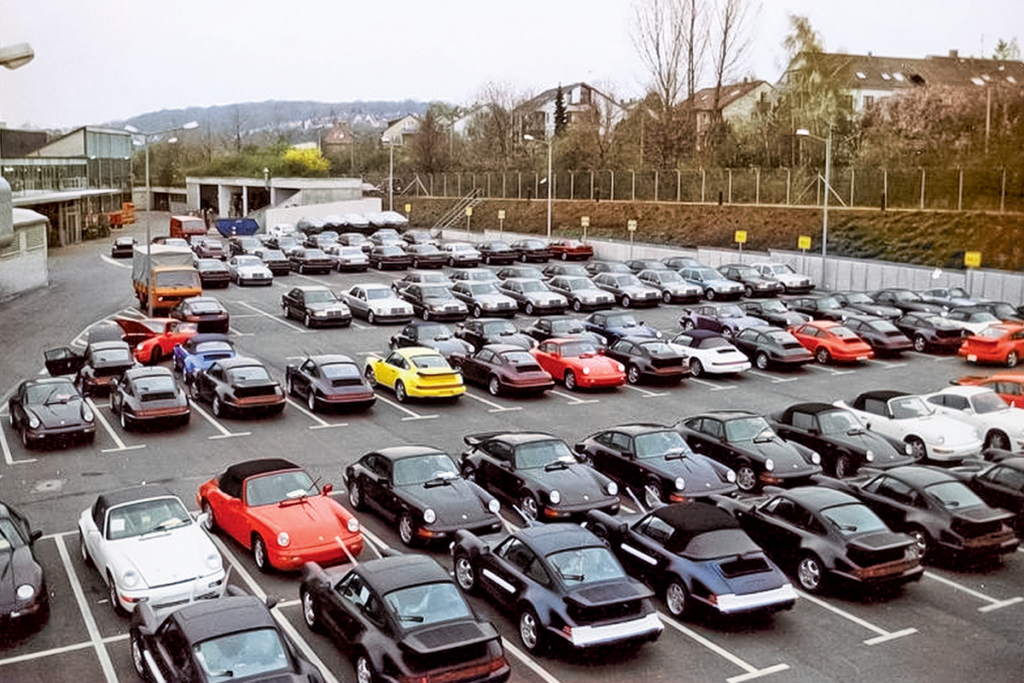
Початок 90-х, готова продукція на заводі в Цуффенхаузені: різні Porsche 964 і сорок Mercedes на задньому плані.
Логістична складність цього процесу була значною; на виготовлення кожного транспортного засобу пішло 18 днів. Незважаючи на це, процес виробництва виявився більш ефективним, ніж у BMW M5. Спочатку Mercedes планував, що Porsche буде випускати десять автомобілів щодня, але через величезний попит темпи виробництва подвоїлися.
За ціною вищою за S-клас у 135 000 німецьких марок, з піком попиту та виробництва в 1992 році, 500 E незабаром перетворився на E 500 як частину рестайлінгу 1993 року, який перетворив всю серію «124» на E-клас. . Незважаючи на те, що техніка залишилася незмінною, зростання ціни до 146 000 марок призвело до падіння продажів, кульмінацією якого стало припинення виробництва в 1995 році. Однак менш потужний 400 E (пізніше E 420) продовжував випускатися до 1996 року в подвоєному обсязі.
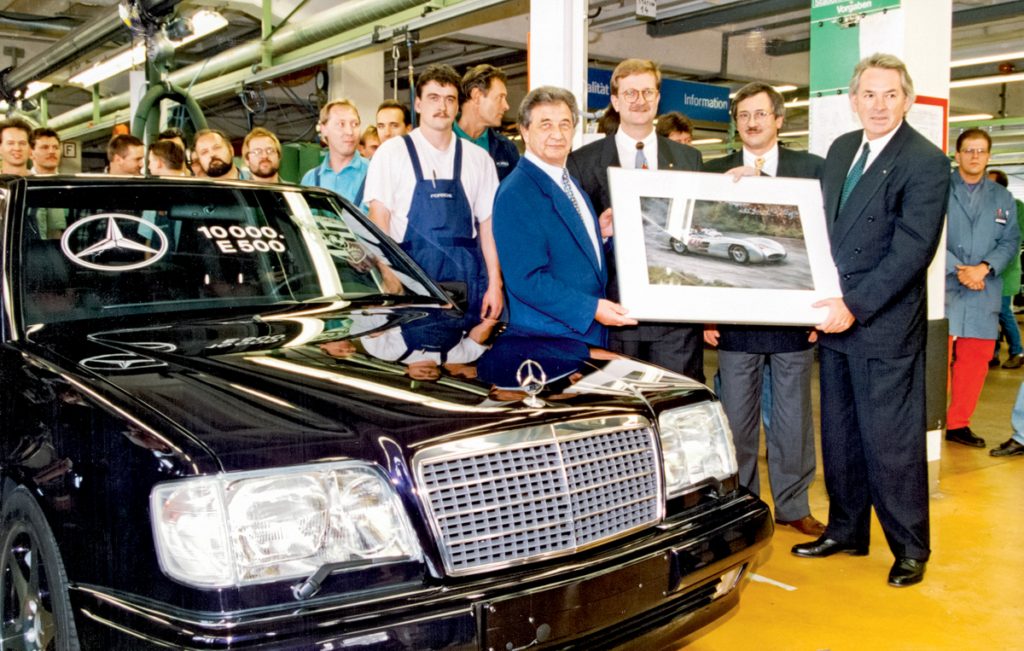
У жовтні 1994 року був випущений 10-тисячний «П’ятсотий» Мерседес — уже з оновленим індексом Е 500. Після цього було зібрано ще 479 одиниць. Автомобіль був подарований Хансу Херрманну, який брав участь у гонках Mercedes у Формулі-1 у 50-х роках, а в 1970 році виграв перший Ле-Ман для Porsche.
Цей проект не тільки стабілізував фінансову ситуацію Porsche, але й створив основу для майбутніх проектів, таких як Audi RS2, де Porsche мав більший інженерний вплив. Керівництво Майкла Хелшера вийшло за межі цього проекту, зробивши внесок у розробку Carrera GT і Porsche 918 Spyder до його виходу на пенсію в 2016 році.
Mercedes, визнавши прибутковий характер продуктивних моделей через проект 500 E, вирішив у 1993 році зберегти цю «ікру» автомобільного бізнесу ексклюзивом, що призвело до випуску першого Mercedes C 36 AMG і заклало основу для майбутнього високого рівня. продуктивні інновації, добре відомі сьогодні.
Фото: BMW | Mercedes-Benz | Сергій Знаємський
Це переклад. Ви можете прочитати оригінальну статтю тут: Ехо друг друга: як створювалися BMW M5 і Mercedes-Benz 500 E з нашого ретротесту

Опубліковано Червень 20, 2024 • 12хв на читання

